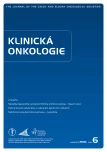Undifferentiated Carcinoma of the Pancreas – a Case Report
Authors:
B. Kašperová 1; S. Jurišová 1; J. Macúch 2; M. Bumberová 3; P. Janega 4,5; J. Dolinský 1; M. Mego 1
Authors‘ workplace:
II. onkologická klinika LF UK a Národný onkologický ústav, Bratislava
1; Oddelenie patologickej anatómie, Národný onkologický ústav, Bratislava
2; Oddelenie radiodiagnostiky, Národný onkologický ústav, Bratislava
3; Ústav patologickej anatómie LF UK a UN Bratislava
4; Ústav normálnej a patologickej fyziológie, Slovenská akadémia vied, Bratislava
5
Published in:
Klin Onkol 2018; 31(6): 453-456
Category:
Case Report
doi:
https://doi.org/10.14735/amko2018453
Overview
Background:
Undifferentiated carcinoma of pancreas (pancreatic cancer – PC) is a rare subtype of malignant PC. It was thought to be a sarcoma of the pancreas due to its typical morphological pattern. There are three histomorphological variants: anaplastic, sarcomatoid, and carcinosarcoma. There is also a separate category: undifferentiated pancreatic carcinoma with osteoclast-like giant cells. In contrast to ductal adenocarcinoma of the pancreas, undifferentiated carcinoma of pancreas is characterized by more aggressive behavior, other predilection localization of tumor and different predilection for localization of tumor and metastasis, a larger primary tumor, and different symptomatology at the time of diagnosis.
Case:
We present the case of a patient who was diagnosed with undifferentiated PC and was treated at the National Cancer Institute in Bratislava. We provide information about the clinical, radiological, and histomorphological characteristics of the disease, along with the diagnostic and therapeutic approach and a brief review of the literature.
Results:
The patient was diagnosed with inoperable locally advanced disease and was treated with first line chemotherapy comprising gemcitabine and cisplatin, followed by second line treatment with FOLFIRINOX. No response was achieved; on the contrary, we observed progression of the disease and deterioration in the patient’s condition. Overall survival was 4.5 months from the time of diagnosis.
Conclusion:
The only appropriate therapeutic approach to this highly malignant disease is most likely “en-bloc” resection, which is possible only at the early stage of the disease. At present, no curative chemotherapy or radiotherapy regimen exists. The dominant features of undifferentiated PC described in the literature are aggressive behavior, an unfavorable prognosis, and chemo-refractoriness.
Key words:
pancreatic cancer – prognosis – chemotherapy
The authors declare they have no potential conflicts of interest concerning drugs, products, or services used in the study.
The Editorial Board declares that the manuscript met the ICMJE recommendation for biomedical papers.
Submitted: 4. 6. 2018
Accepted: 25. 10. 2018
Sources
1. Svod.cz. Epidemiologie zhoubných nádorů v České republice. Masarykova univerzita, 2005. [online]. Dostupné z: www.svod.cz.
2. Bosman FT, Carneiro F, Hruban RH et al. WHO classification of tumours of the digestive systém. In: Fukushima N, Hruban RH, Kato Y et al (eds.). Ductal adenocarcinoma variants and mixed neoplasm of the pancreas. WHO 2010: 292–295.
3. Singhal A, Shrago SS, Li SF et al. Giant cell tumor of the pancreas: a pathological diagnosis with poor prognosis. Hepatobiliary Pancreat Dis Int 2010; 9(4): 433–437.
4. Sommers SC, Meissner WA. Unusual carcinomas of the pancreas. AMA Arch Pathol 1954; 58(2): 101–111.
5. Lewandrowski KB, Weston L, Dickersin GR et al. Giant cell tumor of the pancreas of mixed osteoclastic and pleomorphic cell type: evidence for a histogenetic relationship and mesenchymal differentiation. Hum Pathol 1990; 21(11): 1184–1187.
6. Trepeta RW, Mathur B, Lagin S et al. Giant cell tumor („osteoclastoma“) of the pancreas: a tumor of epithelial origin. Cancer 1981; 48(9): 2022–2028.
7. Sakai Y, Kupelioglu AA, Yanagisawa A et al. Origin of giant cells in osteoclast-like giant cell tumors of the pancreas. Hum Pathol 2000; 31(10): 1223–1229. doi: 10.1053/ hupa.2000.18491.
8. Sakhi R, Hamza A, Khurram MS et al. Undifferentiated carcinoma of the pancreas with osteoclast-like giant cells reported in an asymptomatic patient: a rare case and literature review. Autops Case Rep 2017; 7(4): 51. doi: 10.4322/ acr.2017.042.
9. Loya AC, Ratnakar KS, Shastry RA et al. Combined osteoclastic giant cell and pleomorphic giant cell tumor of the pancreas: a rarity. An immunohistochemical analysis and review of the literature. JOP 2004; 5(4): 220–224.
10. Gullian RA, McMahon J. Pleomorphic adenocarcinoma of the pancreas. Am J Gastroenterol 1973; 60(4): 379–386.
11. Tschang TP, Garza-Garza R, Kissane JM. Pleomorphic carcinoma of the pancreas, an analysis of 15 cases. Cancer 1977; 39(5): 2114–2126.
Labels
Paediatric clinical oncology Surgery Clinical oncologyArticle was published in
Clinical Oncology

2018 Issue 6
Most read in this issue
- Undifferentiated Carcinoma of the Pancreas – a Case Report
- Effect and Toxicity of Radiation Therapy in Selected Palliative Indications
- Consequences of Hypoacidity Induced by Proton Pump Inhibitors – a Practical Approach
- Diagnostic Challenges and Extraordinary Treatment Response in Rare Malignant PEComa Tumor of the Kidney
